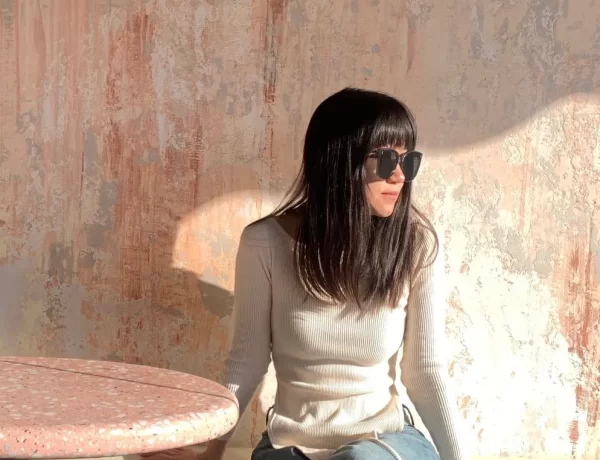There are two types of artists: those who have a vision and create it, and those who create until a vision comes to them. British Columbia-based artist Luis Lopa closely relates to the latter as his large-scale, kaleidoscope-fashioned, and fragmented double-image art pieces stand testament to an artist who does, essentially, nothing by the book. Since earning a degree in Visual Arts, Lopa has become a man whose raw talent and open-minded versatility has lead him to great opportunities and recognition by many, but he’s only getting started. Cliché talks with Lopa about his growth as an artist, what goes into his work, and where you can see him next.
Cliché: You primarily use acrylic paint in much, if not all, of your work. When did you realize this was your favorite medium to work with?
Luis Lopa: I switched to working primarily in acrylic about four years ago, during my last year of school. I used to work in a few other mediums—printmaking and drawing in particular. At the time I felt I needed to streamline my process and focus on making a strong body of work in one medium (which in hindsight might have been poor judgment). Although I’ve worked with a range of materials, I appreciate the simplicity of creating work with one medium and enjoy working with larger-scale pieces.
What is the creative process like when you’re creating a piece?
When I first started painting everything was pretty free-style and intuitive. I’ve carried on that mentality in my current works. However, I feel the new pieces are more informed. I don’t keep a sketchbook, mainly because I feel like past works serve as starting points for new pieces. I do find myself planning aspects of certain pieces, but I like to improvise quite a bit, as it lends a certain clumsiness to the work.
Do you listen to music while you work? If so, what do you listen to?
Music is a big part of the process because it keeps me from getting bored. While I do enjoy many aspects of painting, the reality of it is you’re smearing pigments on a substrate, using fibers on a stick—not too exciting. I listen to a range of music, but lately mostly electronic, hip-hop, and deep house.
What sort of techniques do you use to create such chaotic, and sometimes pixelated, pieces?
The type of work I do makes use of very basic painting techniques and relies heavily on colour and how certain marks and elements are arranged. I like to layer different textures and shapes—forms that seem familiar, but remain anonymous. More recently I’ve been using a lot of tape to create hard edges in the work, which results in a fragmented looking image.
How long does it usually take to finish a piece?
It depends on the size. Large-scale pieces can take a couple of weeks, though I try not to think about time when creating work. Some of the best art was executed in a matter of minutes, while others took years to conceive. Unless I’m trying to meet a deadline, time is irrelevant.
What or who do you draw inspiration from?
The internet. Just kidding. I’m not sure if I can name anyone or anything in particular. Painting has a lineage, and because of this, there will always be an open dialogue with what has been done in the past, which is sometimes fun to play with. I definitely like to draw from all forms of visual culture, whether it be cartoons, books, illustration, film, fashion, and to an extent, music. The music industry interests me because though it is built on sound, a huge part of its culture exists and operates within the visual realm.
Are there any artists you would like to collaborate with?
If interesting opportunities come up, I’m often open to collaborating. I think it would be awesome to collaborate with people in a different field or industry. I would love to work with someone doing textiles or print.
After earning a BA in Visual Arts, would you say an education in art helped shape you as an artist?
Definitely. I feel that the way the curriculum was structured influenced the way I organize references, and ultimately the process in which I work. My particular school focused heavily on theory and conceptually based practice. There was very little technical instruction and come to think of it, I never really learned how to paint in class. We were taught, or in some instances given suggestions, of what “art” was, but were left to our own devices when it came time to create work. Eventually I figured out that I had to acknowledge all that I had learned, and then teach myself how to disregard it.
Your work has graced more than just an ordinary canvas, being printed on pillowcases, ski sets, etc. Can you tell me more about this?
As mentioned earlier, if someone presents me with an interesting opportunity, I’m usually inclined to hop on board. I think it’s awesome that other people are into the work and I usually find myself interested in what they’re doing as well. It’s also fun to see my work taken out of its original context and being used, in some cases like the skis, in a very different and dynamic setting.
Is your work currently being featured in any galleries? If not, would you like to do shows in the future?
I’m not currently being represented by any galleries, but I have done shows in the past. I just wrapped up a group show in March and will be doing a solo show in June.
Luis will be hosting his solo show at Positive Negative Gallery, in Vancouver, BC from June 13th to July 1st. Opening reception will be Friday the 13th at 7pm. For more details, visit: positivenegativegallery.com
To see more of Luis’ work, visit his blog: luislopa.blogspot.com
Images courtesy of Luis Lopa.


